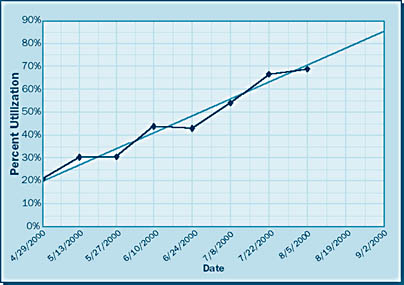Capacity Planning for the Network
3 4
We've saved the network aspect of capacity planning for last because you can't get much capacity planning information from inside the system. Performance Monitor does not provide any counters to reveal network performance data, so sizing a network can be difficult. Given that the network is usually the weakest link in the system chain, try to be realistic in your estimations.
To size the network, you'll need to consider how many concurrent users will be on the system, how many messages are going through per second, and how many bytes per second on average these messages will contain. Based on this information, you can develop some estimates for the necessary minimum bit capacity of the network. For example, a proposed system might transmit the following amounts of data: 10 users will each transmit 25 messages per minute. Each of these messages is 259 bytes in length. We can estimate that the 250 total messages generate 64,750 bytes per minute, or 51,800 bits per minute, or 8633.33 bits per second. A small network would be adequate for this workload. You can use the following formula to estimate network size:
network size = (messages/sec) * (message length) * (bits per byte)
This calculation will give you an idea of how large (in bits per second) the transmission line should be.
This is about all we can do as far as the network is concerned, aside from monitoring network usage. Besides, in most situations you will be given a network to use; you can't really choose another network unless the given network will not support your system.
Collecting Network Usage Data
When you are performing post-capacity planning studies on the network, you should track the Bytes/Sec Through Network Interface performance counter in Network Monitor. This counter represents the percentage of time the data line is busy.
NOTE
Instructions for installing Network Monitor can be found in the Windows 2000 Server Help topic "Installing Network Monitor."
Analyzing Network Usage Data
To analyze network data, first calculate the line capacity (network size) as shown above, and then examine the Bytes/Sec Through Network Interface counter. Using these two values, the following formula will give you the total network utilization:
network utilization = (bytes/sec through the network) / (network size) * 100
Figure 6-8 shows an example of linear growth for a network by graphing network utilization vs. date.

This graph indicates that this particular network segment will reach maximum capacity on September 2, 2000. Again, the more data points you put on the graph, the more accurate the prediction will be.
EAN: N/A
Pages: 264